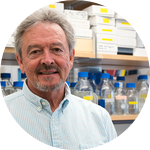
Malcolm Maden
University of Florida Department of Biology & UF Genetics Institute
Professor
More
About
My research is focused on understanding the cellular and molecular regulation of tissue and organ regeneration using several different model systems. This work is based on the principle that regeneration recapitulates development, and, by studying the signaling pathways utilized in development, we hope to induce regeneration in non-regenerating systems. Accordingly I have studied various systems of the body: the nervous system, the limb, and the lung, and evaluated the role that a crucial signaling molecule, retinoic acid (RA), plays in the development of these organs. Following this development to regeneration principle, we have had considerable success at inducing regeneration in non-regenerating mammals by administering RA. Similarly, by examining how signaling pathways are regulated in a naturally regenerating model organism, such as the axolotl (an amphibian with remarkable powers of organ regeneration), we can compare the molecular processes involved in regeneration to non-regenerating repair in a mammal. This helps us understand where the two processes diverge. Most recently, however, we have discovered there is a mammal that can regenerate, the spiny mouse. It can repair full thickness skin wounds, replace hairs and heal without scarring. This has now become the focus of my regeneration studies. Joined
March 2016
Haven't created any projects yet!
Haven't backed any projects yet!
No lab notes posted yet!